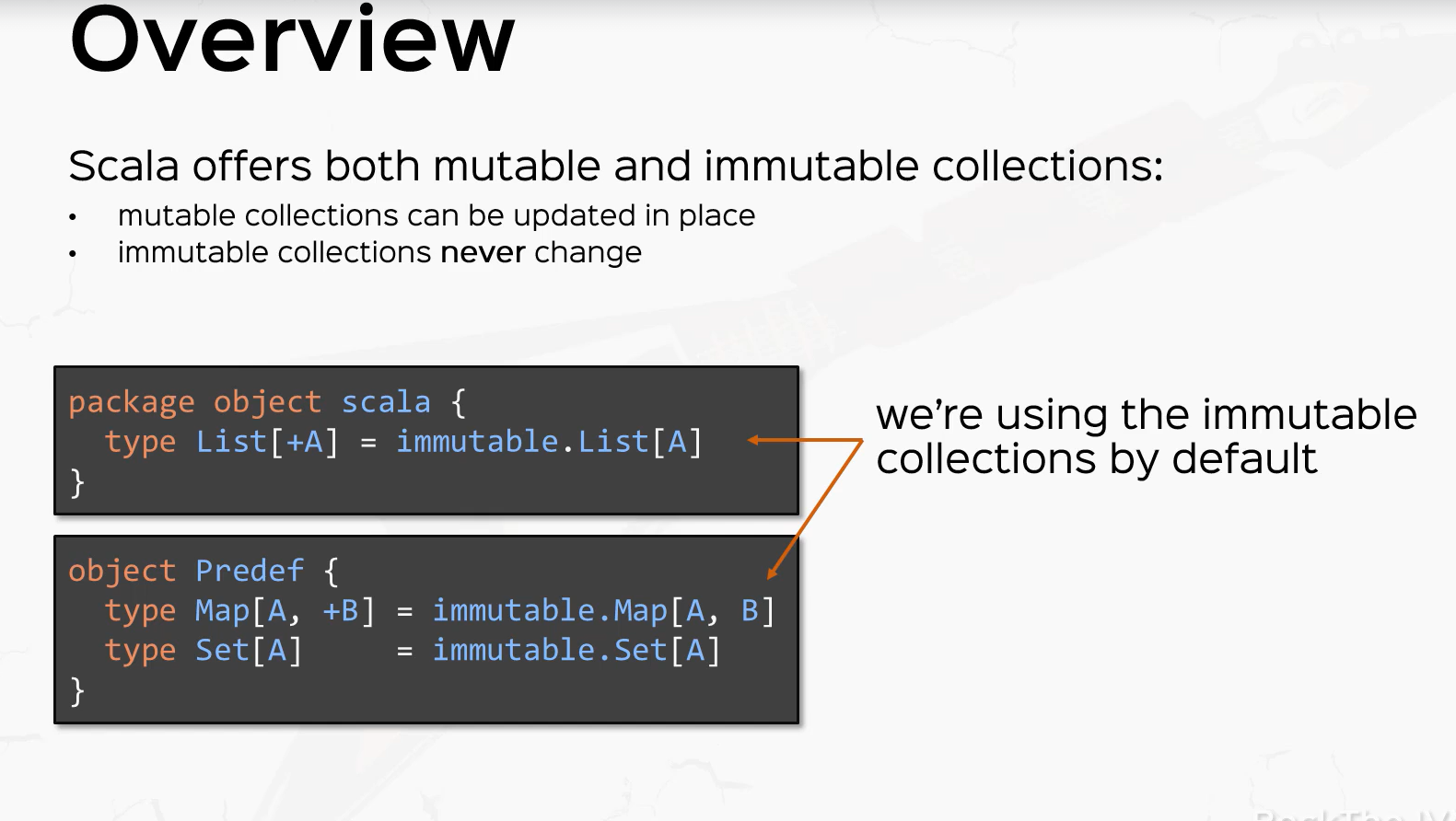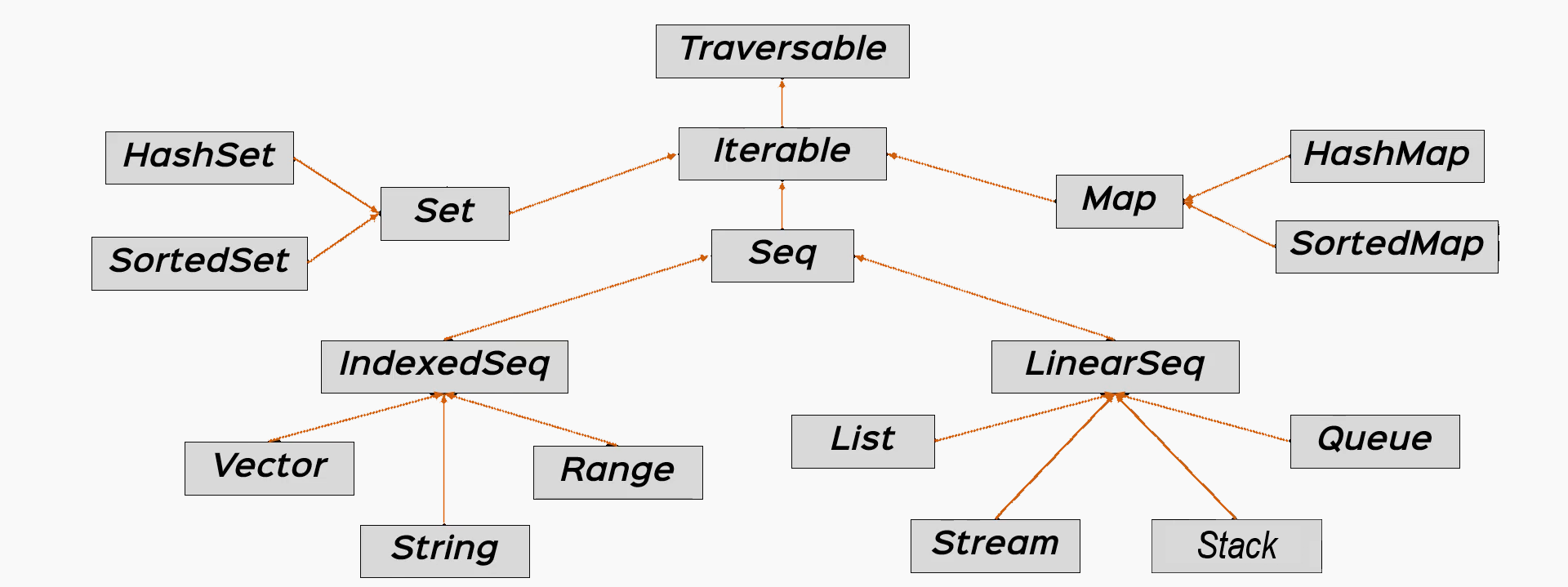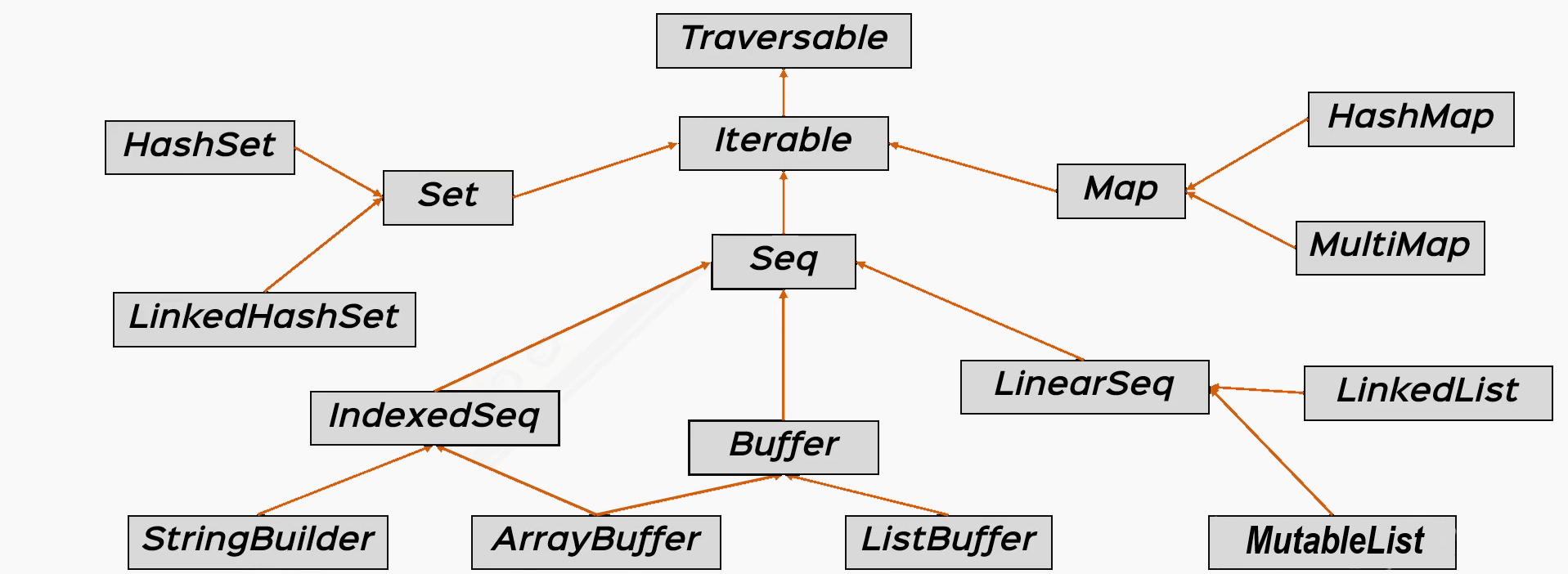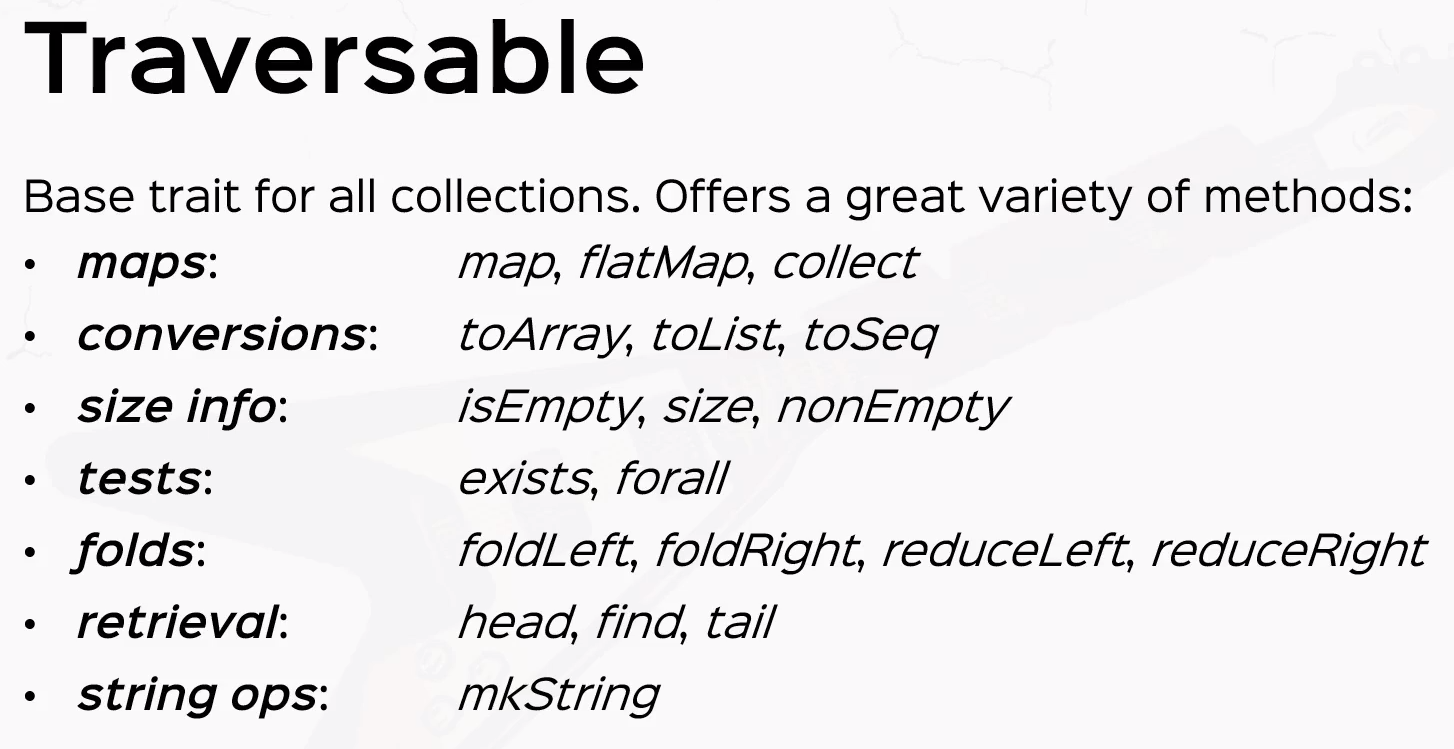ScalaSchool
Scala Collections
Introduction
All scala collections are defined in the following package:
scala.collection // Collections may be mutable or immutable
scala.collection.immutable // The immutable collections. These are usually used by default
scala.collection.mutable // The mutable collections. Array and ArrayBuffer are the most popular of these
Scala defines several collection classes:
Sequences
Two of the most popular collections List and vector are subtypes of Seq see Sequences for more details
on these classes.
Popular Base Classes

Immutable Collections

These are the major immutable classes we use.
List(linked list, provides fast sequential access)Stream(same as List, except that the tail is evaluated only on demand)Vector(array-like type, implemented as tree of blocks, provides fast random access)Range(ordered sequence of integers with equal spacing)String(Java type, implicitly converted to a character sequence, so you can treat every string like aSeq[Char])Map(collection that maps keys to values)Set(collection without duplicate elements)
Mutable Collections

Typically Array is the only mutable collection we use.
Array(Scala arrays are native JVM arrays at runtime, therefore they are very performant)- Scala also has mutable maps and sets; these should only be used if there are performance issues with immutable types
Traversable
Most of the behavior we will use is described in the the top-level collections class Traversable

Examples
val fruitList = List("apples", "oranges", "pears")
// Alternative syntax for lists
val fruit = "apples" :: ("oranges" :: ("pears" :: Nil)) // parens optional, :: is right-associative
fruit.head // "apples"
fruit.tail // List("oranges", "pears")
val empty = List()
val empty = Nil
val nums = Vector("louis", "frank", "hiromi")
nums(1) // element at index 1, returns "frank", complexity O(log(n))
nums.updated(2, "helena") // new vector with a different string at index 2, complexity O(log(n))
val fruitSet = Set("apple", "banana", "pear", "banana")
fruitSet.size // returns 3: there are no duplicates, only one banana
val r: Range = 1 until 5 // 1, 2, 3, 4
val s: Range = 1 to 5 // 1, 2, 3, 4, 5
1 to 10 by 3 // 1, 4, 7, 10
6 to 1 by -2 // 6, 4, 2
val s = (1 to 6).toSet
s map (_ + 2) // adds 2 to each element of the set
val s = "Hello World"
s filter (c => c.isUpper) // returns "HW"; strings can be treated as Seq[Char]
// Operations on sequences
val xs = List(...)
xs.length // number of elements, complexity O(n)
xs.last // last element (exception if xs is empty), complexity O(n)
xs.init // all elements of xs but the last (exception if xs is empty), complexity O(n)
xs take n // first n elements of xs
xs drop n // the rest of the collection after taking n elements
xs(n) // the nth element of xs, complexity O(n)
xs ++ ys // concatenation, complexity O(n)
xs.reverse // reverse the order, complexity O(n)
xs updated(n, x) // same list than xs, except at index n where it contains x, complexity O(n)
xs indexOf x // the index of the first element equal to x (-1 otherwise)
xs contains x // same as xs indexOf x >= 0
xs filter p // returns a list of the elements that satisfy the predicate p
xs filterNot p // filter with negated p
xs partition p // same as (xs filter p, xs filterNot p)
xs takeWhile p // the longest prefix consisting of elements that satisfy p
xs dropWhile p // the remainder of the list after any leading element satisfying p have been removed
xs span p // same as (xs takeWhile p, xs dropWhile p)
List(x1, ..., xn) reduceLeft op // (...(x1 op x2) op x3) op ...) op xn
List(x1, ..., xn).foldLeft(z)(op) // (...( z op x1) op x2) op ...) op xn
List(x1, ..., xn) reduceRight op // x1 op (... (x{n-1} op xn) ...)
List(x1, ..., xn).foldRight(z)(op) // x1 op (... ( xn op z) ...)
xs exists p // true if there is at least one element for which predicate p is true
xs forall p // true if p(x) is true for all elements
xs zip ys // returns a list of pairs which groups elements with same index together
xs unzip // opposite of zip: returns a pair of two lists
xs.flatMap f // applies the function to all elements and concatenates the result
xs.sum // sum of elements of the numeric collection
xs.product // product of elements of the numeric collection
xs.max // maximum of collection
xs.min // minimum of collection
xs.flatten // flattens a collection of collection into a single-level collection
xs groupBy f // returns a map which points to a list of elements
xs distinct // sequence of distinct entries (removes duplicates)
x +: xs // creates a new collection with leading element x
xs :+ x // creates a new collection with trailing element x
// Operations on maps
val myMap = Map("I" -> 1, "V" -> 5, "X" -> 10) // create a map
myMap("I") // => 1
myMap("A") // => java.util.NoSuchElementException
myMap get "A" // => None
myMap get "I" // => Some(1)
myMap.updated("V", 15) // returns a new map where "V" maps to 15 (entry is updated)
// if the key ("V" here) does not exist, a new entry is added
// Operations on Streams
val xs = Stream(1, 2, 3)
val xs = Stream.cons(1, Stream.cons(2, Stream.cons(3, Stream.empty))) // same as above
(1 to 1000).toStream // => Stream(1, ?)
x #:: xs // Same as Stream.cons(x, xs)
// In the Stream's cons operator, the second parameter (the tail)
// is defined as a "call by name" parameter.
// Note that x::xs always produces a List